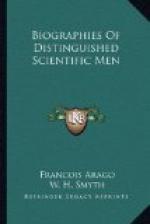Those telescopes, in which the observer, placed at the anterior extremity of the tube, looks direct into the tube and turns his back to the objects, were called by Herschel front view telescopes. In vol. lxxvi. of the Philosophical Transactions he says, that the idea of this construction occurred to him in 1776, and that he then applied it unsuccessfully to a ten-foot telescope; that during the year 1784, he again made a fruitless trial of it in a twenty-foot telescope. Yet I find that on the 7th of September 1784, he recurred to a front view in observing some nebulae and groups of stars. However discordant these dates may be, we cannot without injustice neglect to remark, that a front view telescope was already described in 1732, in volume vi. of the collection entitled Machines and Inventions approved by the Academy of Sciences. The author of this innovation is Jaques Lemaire, who has been unduly confounded with the English Jesuit, Christopher Maire, assistant to Boscovitch, in measuring the meridian comprised between Rome and Rimini. Jaques Lemaire having only telescopes of moderate dimensions in view, was obliged, in order not to sacrifice any of the light, to place the great mirror so obliquely, that the image formed by its surface should fall entirely outside the tube of the instrument. So great a degree of inclination would certainly deform the objects. The front view construction is admissible only in very large telescopes.
I find in the Transactions for 1803, that in solar observations, Herschel sometimes employed telescopes, the great mirror of which was made of glass. It was a telescope of this sort that he used for observing the transit of Mercury on the 9th of November, 1802. It was seven English feet long, and six inches and three tenths in diameter.
Practical astronomers know how much the mounting of a telescope contributes to produce correct observations. The difficulty of a solid yet very movable mounting, increases rapidly with the dimensions and weight of an instrument. We may then conceive that Herschel had to surmount many obstacles, to mount a telescope suitably, of which the mirror alone weighed upwards of 1000 kilogrammes (a ton). But he solved this problem to his entire satisfaction by the aid of a combination of spars, of pulleys, and of ropes, of all which a correct idea may be formed by referring to the woodcut we have given in our Treatise on Popular Astronomy (vol. i.). This great apparatus, and the entirely different stands that Herschel imagined for telescopes of smaller dimensions, assign to that illustrious observer a distinguished place amongst the most ingenious mechanics of our age.




